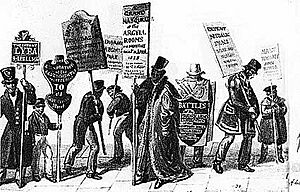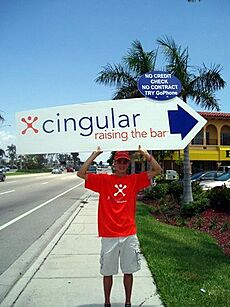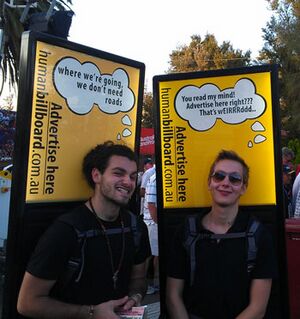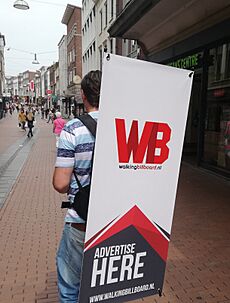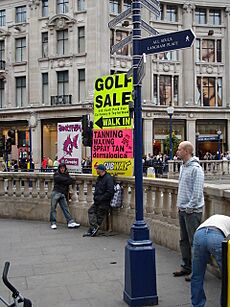Human billboard facts for kids
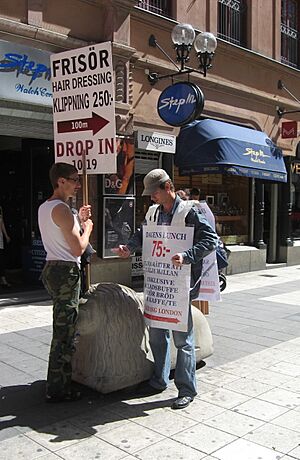
A human billboard is a person who carries or wears an advertisement to promote a product or business. This can be as simple as holding a sign, but it can also mean wearing special clothing. In some rare cases, people have even been paid to get tattoos of company logos.
People who hold signs for businesses are often called human directionals because they point people in the right direction. You might also hear them called sign walkers, sign wavers, or sign spinners. To get people's attention, they often spin their signs, dance, or wear fun costumes.
Contents
History of Human Billboards
Using people as walking advertisements is not a new idea. It has been happening for centuries. The practice became very popular in 19th-century London. At the time, putting up posters on walls became expensive because of a new tax. Also, there was not enough wall space for all the ads.
A German prince named Prince Pückler-Muskau visited London in the 1820s and wrote about what he saw:
Formerly people were content to paste advertisements up; now they are ambulant (walking). One man had a pasteboard hat, three times as high as other hats, on which is written in great letters, "Boots at twelve shillings a pair—warranted".
Besides holding signs, some people wore sandwich boards. These are two signs worn over the shoulders, one on the front and one on the back. The famous author Charles Dickens described these advertisers as "a piece of human flesh between two slices of paste board."
In 1839, a new law in London banned posters on private property. This made human billboards even more common. After a while, people got used to seeing them, so advertisers had to get more creative. They would sometimes have a whole parade of people with the same sign or make them wear silly costumes to attract attention.
Human Billboards Today
Human directionals are still very popular today, especially in places with many people walking or driving by. When they are trying to attract cars, the signs are often shaped like arrows to point drivers toward the business.
What is Sign Spinning?
Modern sign holders often do amazing tricks to get noticed. This is called sign spinning. They might spin the sign on one finger, throw it high in the air, or even pretend to ride it like a horse. Some companies hold special "boot camps" to train their employees to do these cool moves.
However, some city leaders worry that these tricks can distract drivers and cause accidents. Because of this, some cities have banned sign spinning.
Where Can You See Them?
Human billboards are very effective. For example, one housing company found that many of its visitors came because they saw a sign spinner. You can often see human billboards working year-round in places with good weather.
In the United States, you might see them around tax season, which ends on April 15. People will dress up in costumes like the Statue of Liberty or Uncle Sam to advertise for tax preparation companies.
You can also spot them outside of Halloween stores. Since these stores are often temporary, they use sign wavers in spooky costumes to let everyone know where they are.
Wearing the Advertisement
T-Shirts and Clothing
Using clothing for advertising is also very common, and T-shirts are one of the most popular ways to do it. T-shirts were first made to be worn as undergarments. But by the 1930s, people started printing ads on them. A promotional T-shirt for the 1939 movie The Wizard of Oz is now a valuable collector's item.
During the 1948 United States presidential election, a T-shirt was made that said "Dew It for Dewey" to support the candidate Thomas Dewey. That shirt is now in the Smithsonian Institution museum. Today, T-shirts are used to advertise everything from sodas and bands to political messages.
Tattoos as Ads
Believe it or not, some people get paid to have tattoos of company logos on their bodies. In 2001, a boxer named Bernard Hopkins was paid $100,000 to wear a temporary tattoo on his back during a championship fight. He was the first athlete to wear an ad like this during a professional sports event. The idea was a success, and the company's website got a lot more visitors.
The first person known to get a permanent ad tattoo was Jim Nelson in 2003. He was paid $7,000 to have a company's logo tattooed on the back of his head. In 2005, a man named Andrew Fischer sold his forehead as ad space on eBay for 30 days. The winning bid was $37,375 for a temporary tattoo. Since then, getting paid for tattoos has become more common, and even big companies like Toyota have used this type of advertising.
Other Creative Ideas
Companies are always looking for new ways to grab people's attention.
- When Microsoft launched its Windows Vista software, it created a "human billboard" that was like a performance art show. People were safely hung from the side of a building and moved large banners to create the Vista logo.
- Two college students, Ross Harper and Edward Moyse, started a website called BuyMyFace.com to pay off their student loans. Every day for a year, they painted a different company's logo on their faces and posted a picture online.
Rules for Human Billboards
In many places, you can't just walk anywhere with a giant sign. This type of advertising is sometimes against the law.
For example, London has had laws about walking advertisements for a very long time. As far back as the 1800s, people needed permission from the police to carry signs for advertising in the streets. These rules are meant to keep the streets from getting too crowded and to make sure everyone stays safe.
See also
- Stanley Green (Protein Man), a famous man in London who walked around with signs for many years
- Forehead advertising
- Sandwich board
- Chindon'ya - traditional walking advertisements in Japan


